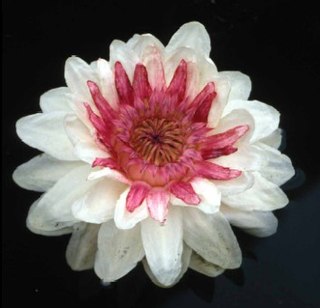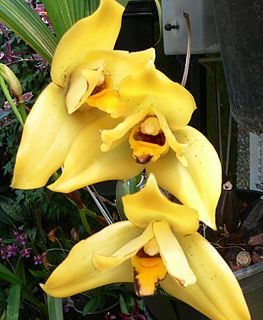Related Research Articles

Orchidaceae, commonly called the orchid family, is a diverse and widespread family of flowering plants, with blooms that are often colourful and fragrant.

Cattleya is a genus of orchids from Costa Rica south to Argentina. The genus is abbreviated C in trade journals.

Laelia is a small genus of 25 species in the orchid family (Orchidaceae). Laelia species are found in areas of subtropical or temperate climate in Central and South America, but mostly in Mexico. Laelia is abbreviated L. in the horticultural trade.

Botryotinia fuckeliana is a plant pathogen, and the causal agent of gray mold disease.
Diplodia laelio-cattleyae is a fungal plant pathogen.
Uredo behnickiana is a fungal plant pathogen. It is known as a pathogen of Cattleya orchids.
Uredo nigropuncta is a fungal plant pathogen. It is known as a pathogen of Cattleya orchids.

The Flora of Colombia is characterized by 130,000 species of plants that have been described within Colombian territory.
This page lists orchid species according to their respective distribution range.

The term grex, derived from the Latin noun grex, gregis, meaning 'flock', has been expanded in botanical nomenclature to describe hybrids of orchids, based solely on their parentage. Grex names are one of the three categories of plant names governed by the International Code of Nomenclature for Cultivated Plants; within a grex the cultivar group category can be used to refer to plants by their shared characteristics, and individual orchid plants can be selected and named as cultivars.

Cattleya granulosa is a bifoliate Cattleya species of orchid. It is endemic to Brazil; the type specimen was reported to come from Guatemala, but this is likely erroneous. The diploid chromosome number of C. granulosa has been determined as 2n = 40.

Cattleya intermedia, the intermediate cattleya, is a bifoliate Cattleya species of orchid. The diploid chromosome number of C. intermedia has been determined as 2n = 40.

Cattleya mossiae, commonly known as easter orchid, is a species of labiate Cattleya orchid. The white-flowered form is sometimes known as Cattleya wagneri. The diploid chromosome number of C. mossiae has been determined as 2n = 40. The haploid chromosome number has been determined as n = 20.

Cattleya warscewiczii, a labiate Cattleya, is a species of orchid.

Cattleya crispa is a species of orchid indigenous to the Tijuca Mountains north of Rio de Janeiro, Brazil, noted for its crisped and ruffled petals and lip. It is the type species for both the subgenus Cattleya subg. Crispae and its section Cattleya sect. Crispae.

Cattleya rex is a species of epiphytic orchid of showy white flowers, native to montane forests in Peru and Bolivia.

Cattleya elongata, the "cattleya with the elongated stalk", is an orchid species in the genus Cattleya endemic to the campo rupestre vegetation in northeastern Brazil.

Cattleya × elegans is a hybrid orchid in the subtribe Laeliinae. It is a pseudobulb epiphyte. Its formula hybridae is Cattleya purpurata Van den Berg (2008) × Cattleya tigrina A.Rich. (1848). It is found in South and South-East Brazil.
The Cattleya Sho is a flat horse race in Japan open to two-year-old horses. It is run at Tokyo Racecourse over a distance of 1600 metres.
Summertime is an Italian drama streaming television series produced by Cattleya that premiered on Netflix on 29 April 2020. The series stars Rebecca Coco Edogamhe, Ludovico Tersigni, and Amanda Campana. It takes place at a small town on the Adriatic coast, Cesenatico, and revolves around Summer and her love life. It is inspired by Three Meters Above the Sky by Federico Moccia.